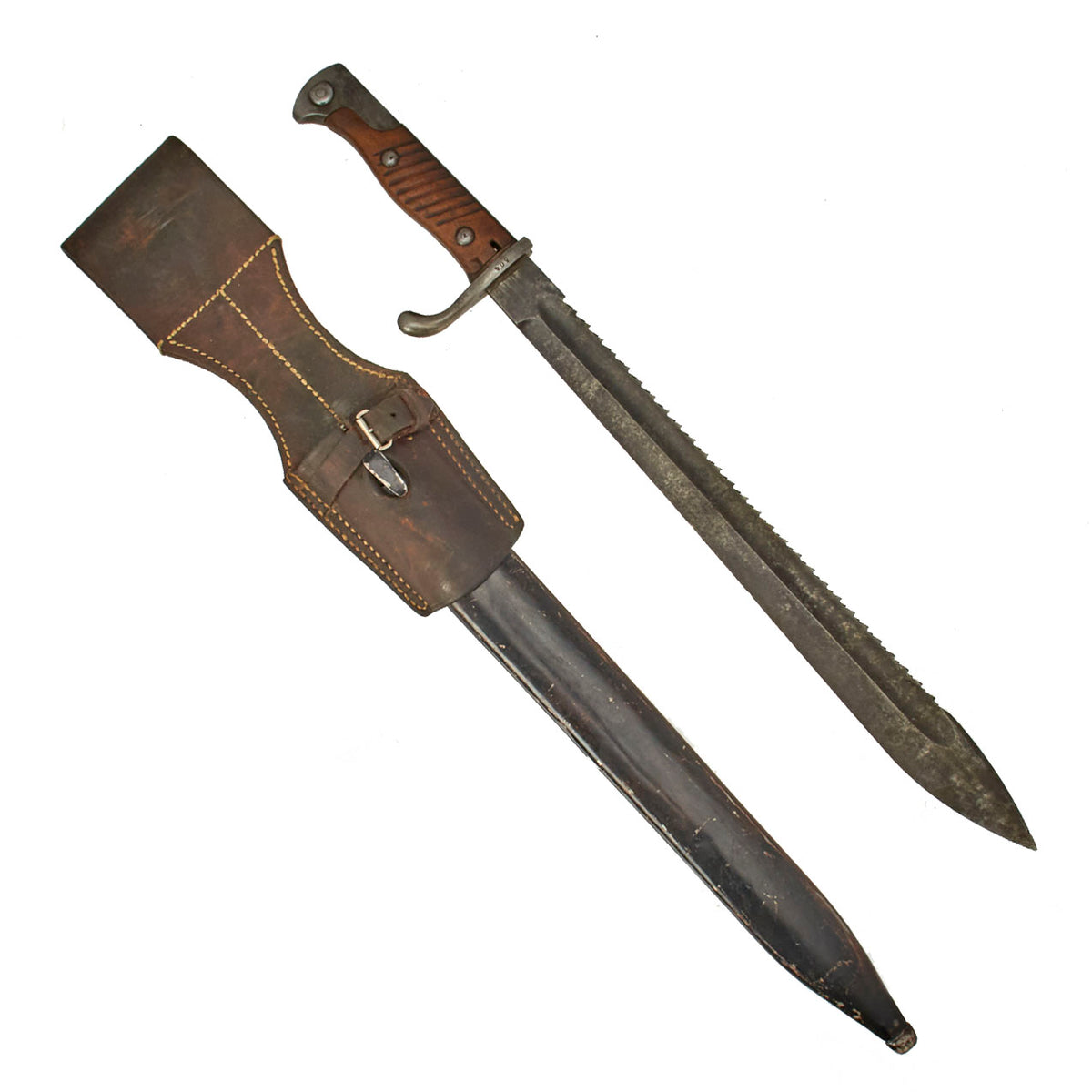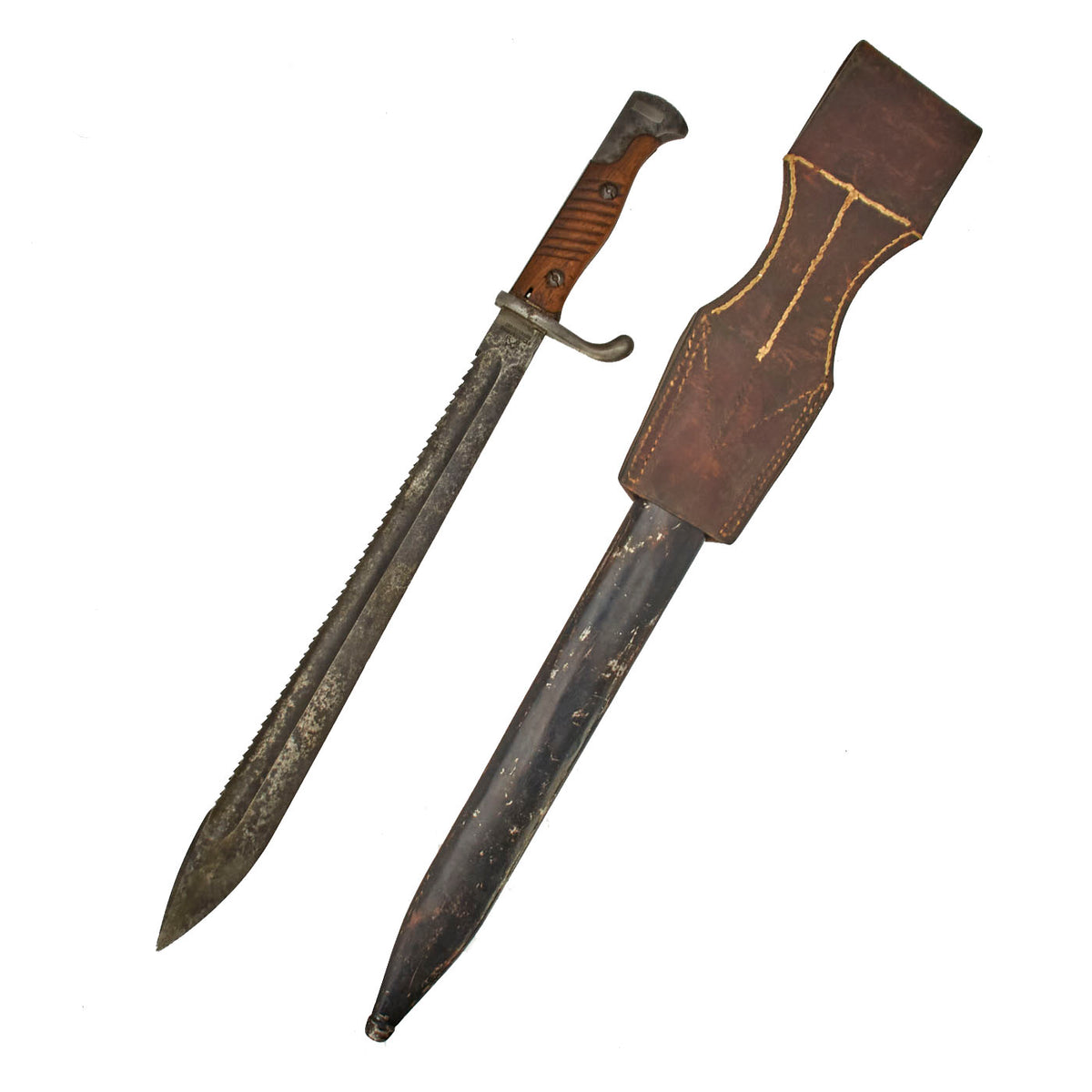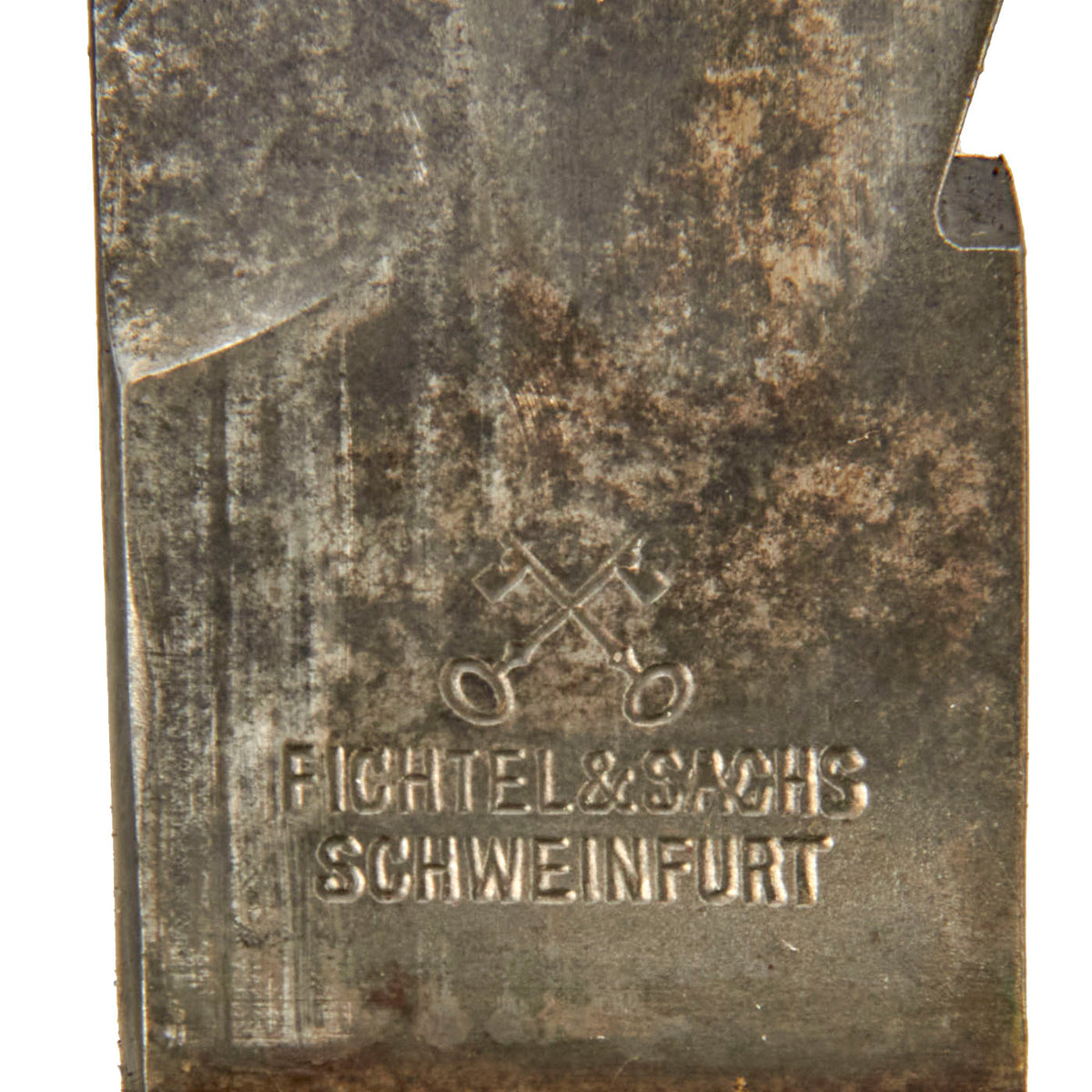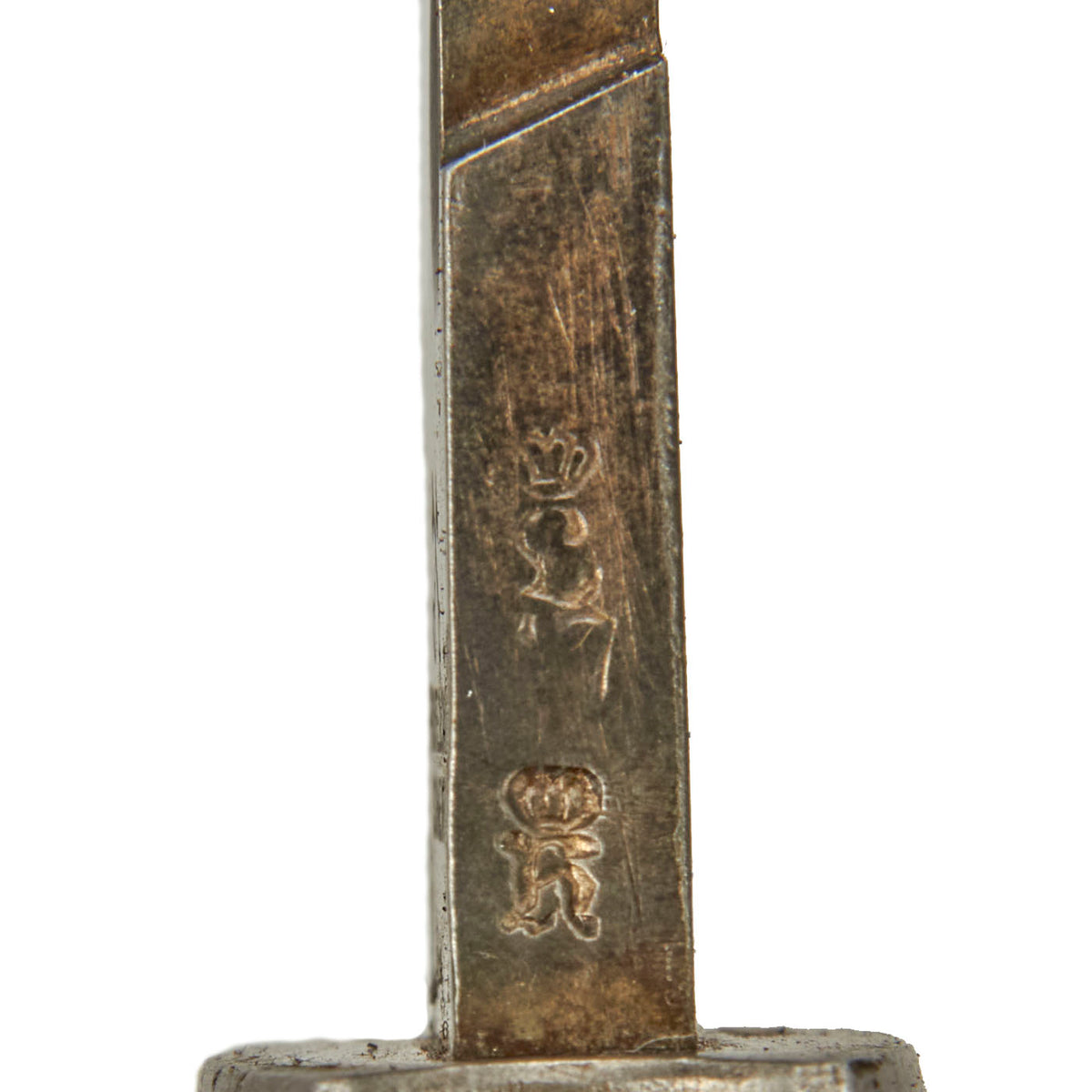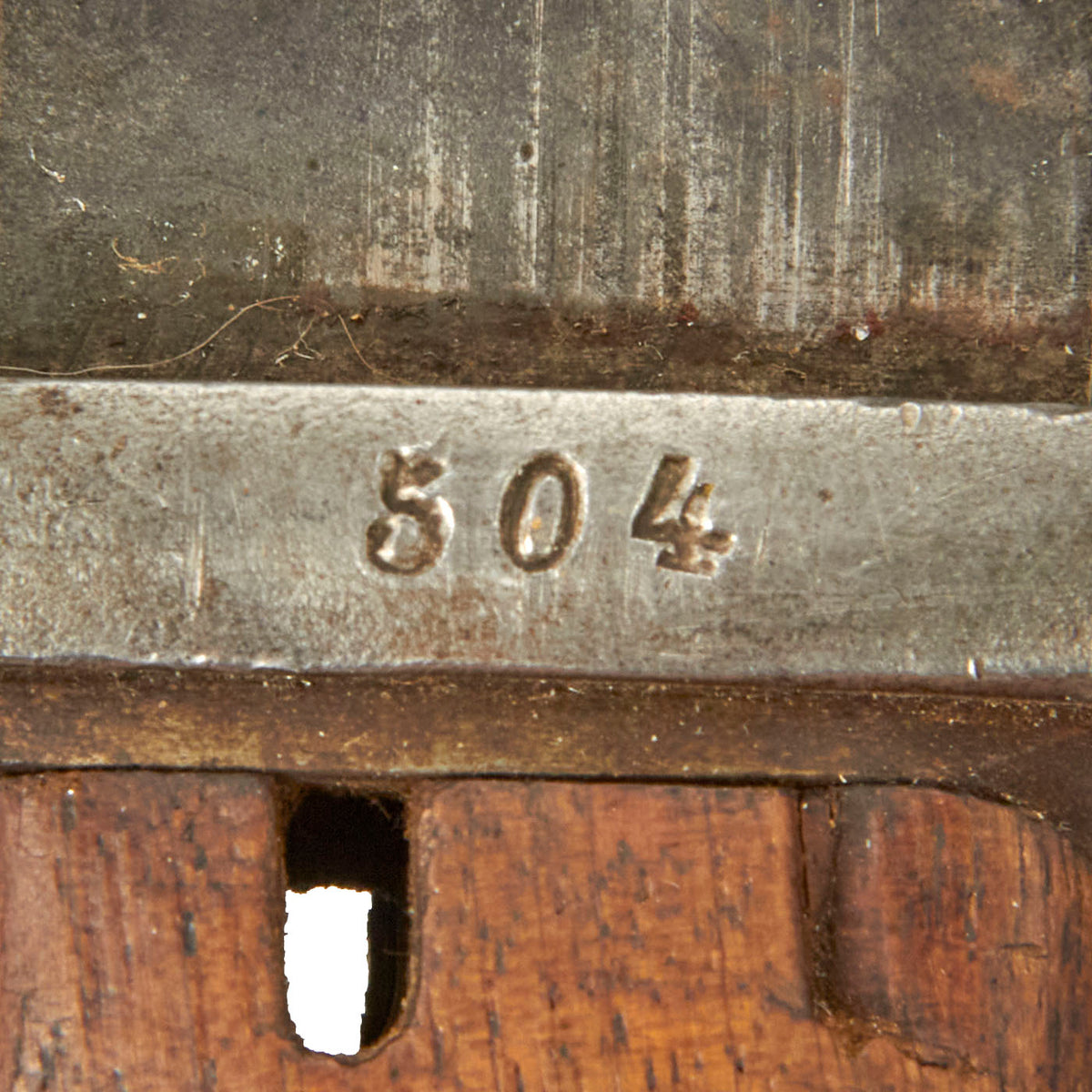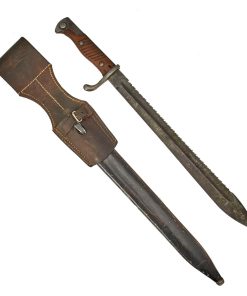Original German WWI M1898/05 n/A Butcher Sawback Bayonet by Fichtel & Sachs dated 1917 with Steel Scabbard & Frog Original Items
$ 495,00 $ 148,50
Original Item: Only One Available. This is a very good example of the M-1898/05 Bayonet (Seitengewehr), which was the most common German Bayonet of the First World War. It was intended for use on the standard issue service rifle of Imperial Germany: the Mauser-designed Gewehr 98 (GEW 98). It features a heavy 14.5-inch steel blade with distinct bulge toward the point, giving extra weight and power to the business end, known as a “butcher blade”. This version is known as n/A (neuer Art = newer model). This second pattern lacks the first pattern’s vestigial muzzle ring (or ‘ears’) and has a flashguard on the back of the grip. For more information please see Watts & White, THE BAYONET BOOK, page 124, illustration 270.
This example has a very desirable “sawback” blade, which was intended for use by pioneers to saw through brush and obstacles. Unfortunately a rumor got out that it was intended to inflict grievous harm on enemies, so a lot of the sawback bayonets had this feature removed, making them hard to find. This example has a blade in very good condition. There is little staining or rust, just overall wear from cleaning. It does not appear to have been sharpened much, and the sawback itself is in excellent condition.
The pommel has a nice set of original grooved wood grips, though they are somewhat
dark in color due to staining, and the hilt has some surface oxidation due to age. Bayonet lock is fully functional. The blade ricasso is maker marked:
(CROSSED KEYS)
FICHTEL & SACHS
SCHWEINFERT
Per J. Anthony Carter’s fine work GERMAN KNIFE AND SWORD MAKERS, the Fichtel & Sachs company was founded in 1895 by Karl Fichtel and Ernst Sachs, originally for making ball bearings and bicycle parts. They also made S.98/05 Bayonets for the Bavarian Government from 1915-1918, and during 1916-1917, many blades bore the “Crossed Keys” of Friedrich Herder Abraham Sohn of Solingen. This indicates that they supplied the blade blanks for these bayonets, of which this is one example.
The blade is dated on the blade’s spine 17 under a proof mark of a Crown over L, for King Ludwig III of Bavaria, and indicating the date it was accepted into service. Ludwig reigned as king from 1913 until 1918, when the Monarchy was abolished. Previously he had been the Prince Regent 1912-1913, as his cousin Otto was technically the King, however he was deemed unfit for rule, so his uncle and later cousin ruled in his stead. There is also an inspector proof under the date marking.
The blade is in good condition, though it does have some staining and wear, and has been sharpened, though not enough to change the blade shape. Please consult the pictures for condition details.
The steel scabbard is in good condition and the original blued finish is mostly present and there are areas of light surface rust, typical of a 100 year old scabbard. The frog button is still intact and unbent. The scabbard is held by a nice original brown leather frog (Seitengewehrtragetasche), which shows quite a bit of age. It still has the original stitching and rivets intact with securing strap and buckle. The belt loop is completely intact and serviceable.
A fine example of what is becoming a difficult bayonet to find in such fine condition, never messed with, just the way we like to find them, ready to display.
Dimensions:
Blade length: 14 1/2”
Blade Style: Single Edged “Butcher” with Fuller & Sawback
Overall length: 19 3/4”
Crossguard: 2 3/4”
Scabbard length: 15 1/4″
Fast Shipping with Professional Packaging
Thanks to our longstanding association with UPS FedEx DHL, and other major international carriers, we are able to provide a range of shipping options. Our warehouse staff is expertly trained and will wrap your products according to our exact and precise specifications. Prior to shipping, your goods will be thoroughly examined and securely secured. We ship to thousands clients each day across multiple countries. This shows how we're dedicated to be the largest retailer on the internet. Warehouses and distribution centres can be located throughout Europe as well as the USA.
Note: Orders with more than one item will be assigned a processing date depending on the item.
Before shipping before shipping, we'll conduct a thorough inspection of the items you have ordered. Today, the majority of orders will be delivered within 48 hours. The delivery time will be between 3-7 days.
Returns
The stock is dynamic and we cannot completely manage it because multiple stakeholders are involved, including our factory and warehouse. So the actual stock may alter at any time. It's possible that you may not receive your order once the order has been made.
Our policy is valid for a period of 30 days. If you don't receive the product within 30 days, we are not able to issue a refund or an exchange.
You can only return an item if it is unused and in the same state as the day you received it. You must have the item in its original packaging.
Related products
Uncategorized
Uncategorized
Uncategorized
Uncategorized
Uncategorized
Uncategorized
Uncategorized
Band of Brothers ORIGINAL GERMAN WWII Le. F.H. 18 10.5cm ARTILLERY PIECE Original Items
Uncategorized
Australian WWII Owen MK1 Machine Carbine SMG Custom Fabricated Replica with Sling Original Items
Uncategorized
Uncategorized
Uncategorized
Armored Burgonet Helmet & Polearm from Scottish Castle Leith Hall Circa 1700 Original Items
Uncategorized
Uncategorized
Uncategorized
Uncategorized
Uncategorized
Armoured Fighting Vehicles of the World: AFVs of World War One (Hardcover Book) New Made Items
Uncategorized
Uncategorized
Uncategorized
